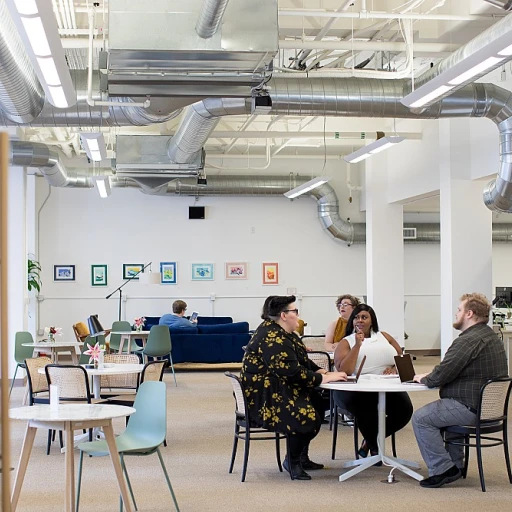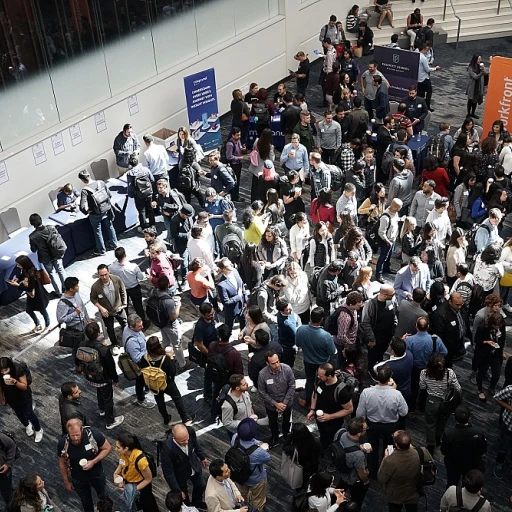
Understanding the Importance of Student Engagement in Reskilling
Why Student Engagement Matters in Reskilling
In the realm of reskilling, student engagement is a cornerstone of effective learning. As the demand for new skills rises, particularly in the fast-evolving job market, ensuring that students are actively involved in their learning experiences is crucial. Engaged students are more likely to absorb information, apply new skills, and ultimately achieve success in their courses.
Engagement in the classroom is not just about keeping students occupied. It involves creating an interactive environment where students feel motivated and supported. This is especially important in reskilling programs, where learners often juggle multiple responsibilities. By fostering a sense of involvement, educators can help students feel more connected to the material, leading to improved student learning outcomes.
Moreover, engagement tools play a pivotal role in this process. They provide real-time feedback and support, allowing teachers to adapt their strategies to meet the needs of their students. This adaptability is key in higher education settings, where diverse learning styles and backgrounds are common. As we explore in the transformative impact of generative AI, technology is reshaping how we approach student engagement, offering innovative solutions to traditional challenges.
In subsequent sections, we will delve deeper into how technology enhances engagement and explore advanced tools that are making a significant difference in reskilling efforts. By understanding the importance of student engagement, educators can better equip themselves to create dynamic and effective learning environments.
The Role of Technology in Enhancing Engagement
The Tech Revolution in the Classroom
In the rapidly evolving landscape of reskilling, technology has become a cornerstone in enhancing student engagement. The advent of digital tools has transformed the conventional classroom setting into an interactive hub, fostering active learning and captivating student interest more than ever before.
With technology, students experience real-time learning opportunities, enabling immediate feedback and adaptative engagement strategies. This approach ensures that students don't just passively absorb information but actively participate in their learning processes. According to a recent analysis by Reskilling Trends, AI tools are reshaping the way educators implement these strategies, making reskilling efforts more effective (learn more).
Transformative Tools for Engagement
The market is burgeoning with advanced tools designed to elevate the learning experience. Here is how technology supports educators and engages students effectively:
- Interactive Platforms: Modern platforms incorporate gamification and real-time quizzes to make learning more dynamic and ensure students remain engaged throughout the course duration.
- Course Evaluations: Technology enables detailed data collection during course evaluations, providing teachers with valuable insights into student learning and engagement levels.
- Open-ended Feedback: These tools facilitate open-ended feedback loops, encouraging students to voice their opinions on course material and teaching methods.
By harnessing these technologies, students feel more supported and empowered to participate actively, leading to improved student success rates in both reskilling initiatives and higher education sectors.
As we delve deeper into specific success stories and future trends, it becomes evident that the integration of technology in reskilling is not just an enhancement, but a necessity for improving long-term educational outcomes.
Advanced Tools Making a Difference
Innovative Solutions Making Waves in Learning Environments
In today's dynamic educational landscape, advanced tools bring a transformative effect to classroom engagement. As technology evolves, so does the potential to create interactive and immersive learning experiences that captivate students' attention and drive educational success. Firstly, the proliferation of interactive platforms allows teachers to present concepts in engaging and diverse ways. Tools such as virtual reality augment the traditional classroom, providing students with immersive environments that help make abstract ideas tangible. This immersion can contribute significantly to active learning and keep students engaged, fostering a deeper understanding of the material. Secondly, real-time feedback systems have proven essential in reinforcing student learning. Technology-enabled platforms that provide instant feedback empower learners to correct mistakes and enhance their understanding on the spot. This immediate response boosts classroom engagement and accommodates various learning paces, ensuring no student is left behind. Moreover, data analytics has revolutionized the way educators understand student engagement. With these insights, teachers can tailor their approach to meet individual students' needs, thus improving student engagement and success. By continually assessing data, adjustments can be made to optimize course delivery, which is vital for higher education institutions aiming to improve student outcomes. The trend toward open-ended engagement strategies is also noteworthy. Platforms offering courses free of rigid structures allow students to pursue subjects at their own pace, encouraging a more personalized learning journey. This flexible approach aligns with students' real-time schedules and fosters a sense of control and commitment to their educational paths. Lastly, the role of technology in supporting student success cannot be overstated. From collaborative tools that enable seamless communication among peers to digital assessments that replace traditional exams, innovation continues to redefine how students engage with learning materials. These advanced tools are indispensable in crafting proactive educational environments that prioritize not only intellectual growth but also emotional support. For a comprehensive understanding of how technology is reshaping workforce reskilling, you can explore more about its role in education here. Such tools not only support education but exemplify a commitment to continuously improving student success across diverse landscapes.Case Studies: Success Stories in Reskilling
Practical Implementations in Real-world Scenarios
In today's reskilling landscape, the harnessing of advanced engagement tools has shown notable success stories, driving transformative changes in education. These case studies serve as compelling examples of how strategic use of technology enhances student learning, showcasing clear pathways to boost student engagement.
One such implementation is within the realm of higher education, where interactive tools have been deployed in the classroom to foster active learning. Through real-time feedback mechanisms, educators support students in a more personalized manner, helping to engage students effectively. With these tools, students feel more connected to the course content, improving their learning experiences significantly.
In addition, advanced analytics platforms provide invaluable data that help teachers tailor their engagement strategies. By tracking student success and classroom engagement metrics, instructors can adjust their methods, ensuring that students remain actively involved throughout the course duration. This data-driven approach not only aids in refining teaching methods but also enhances overall student satisfaction.
On the technological front, tools that facilitate open-ended discussions and collaborative projects have played a major role in student engagement. These technologies encourage students to read, participate and contribute in ways that traditional methods couldn't. The result is a more dynamic education environment, where students are motivated to explore and learn at their own pace.
Such success stories underline the potential of leveraging technology to transform education, making it more interactive and student-centric. This approach doesn't come without its challenges, yet the positive outcomes in these real-world examples show promising avenues for further exploration and adoption in reskilling.
Challenges and Considerations
Overcoming the Barriers
In the pursuit of improving student engagement, educators face several hurdles that can hinder their progress. One significant challenge lies in the adaptation to new technologies. As advanced tools and digital platforms evolve, teachers may struggle to keep pace, requiring ongoing training and support to ensure effective use in the classroom. This necessity underscores the importance of continuous professional development programs to support educators in their journey. Another prevalent obstacle is the need for reliable data. Student engagement strategies often depend on collecting and analyzing real-time data to refine methods and approaches. However, accessing high-quality data can be difficult, especially in institutions where resources are limited. Additionally, teachers must navigate concerns regarding students' privacy and data protection. Balancing the integration of innovative tools with traditional educational practices also emerges as a critical challenge. While interactive technology holds the potential to dramatically enhance learning environments, it is essential to maintain core educational values and not let technology overshadow the fundamental aspects of teaching. Educators must strive to create a harmonious blend that benefits both students and teachers alike. Lastly, when implementing advanced tools, educators must consider the diversity of students and their varying needs. Effective engagement requires a personalized approach that takes into account different learning styles and potential hurdles, such as language barriers and accessibility needs. By acknowledging these differences, teachers can better help students feel included and supported in their learning journey. The journey toward improving student success through enhanced student engagement is fraught with challenges. However, with a focus on continuous learning, adaptability, and a commitment to inclusivity, educators can navigate these obstacles and create enriching educational experiences for all students.Future Trends in Student Engagement Tools
Emerging Technologies Shaping the Future
As we look to the future of student engagement in reskilling, emerging technologies are set to play a pivotal role. With the rapid advancement of technology, tools that were once considered futuristic are now becoming integral to the learning experience. These innovations are not just enhancing engagement but are also transforming how students interact with content and each other in the classroom.
Personalized Learning Experiences
One of the most promising trends is the shift towards personalized learning experiences. By leveraging data and analytics, educators can tailor courses to meet the individual needs of students. This approach not only helps students feel more connected to the material but also improves student success by addressing their unique learning styles and challenges.
Real-Time Feedback and Interaction
Real-time feedback mechanisms are becoming increasingly important in maintaining classroom engagement. Tools that provide instant feedback allow students to adjust their learning strategies on the fly, fostering a more dynamic and interactive learning environment. This immediacy helps keep students engaged and supports active learning, which is crucial for student success.
Integration of AI and Machine Learning
Artificial intelligence and machine learning are also making significant inroads into education. These technologies can analyze vast amounts of data to provide insights into student engagement and learning patterns. By understanding these patterns, educators can develop more effective engagement strategies and improve overall student learning outcomes.
Challenges and Considerations
While the future of student engagement tools is promising, there are challenges to consider. Issues such as data privacy, the digital divide, and the need for teacher training on new technologies must be addressed to ensure these tools are used effectively. Additionally, the pricing of these advanced tools can be a barrier for some institutions, although many are exploring free or low-cost options to make these innovations accessible to all.
Conclusion: A Bright Future Ahead
The future of student engagement in reskilling is bright, with technology offering new ways to engage students and enhance learning experiences. As educators and institutions continue to explore these tools, the potential for improved student success and more effective learning environments becomes increasingly attainable.













